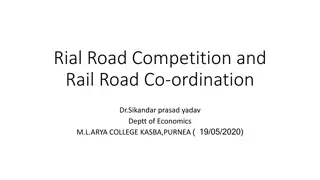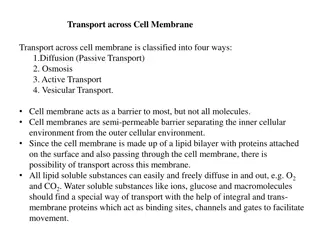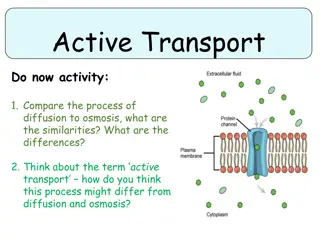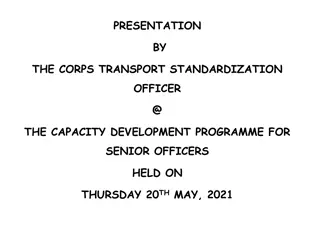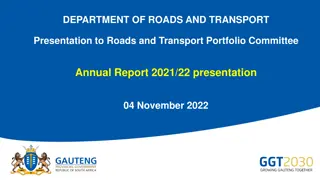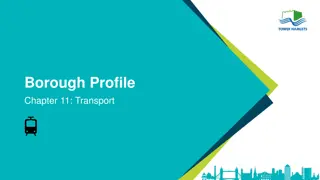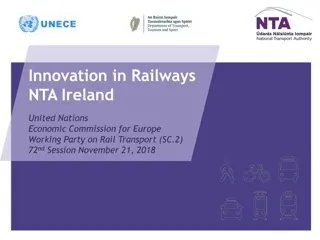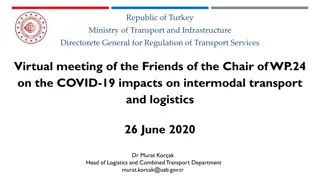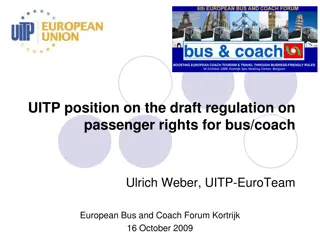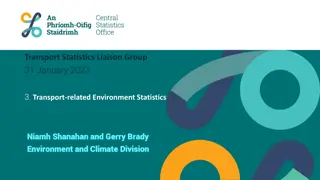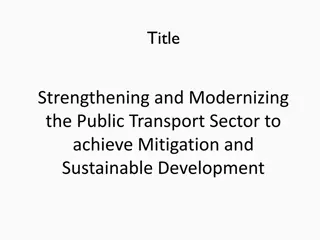
Transport Layer Services in Computer Networking
Explore the principles behind transport layer services such as multiplexing/demultiplexing, reliable data transfer, flow control, and congestion control in computer networking. Learn about UDP and TCP protocols, and why a transport layer is essential for end-to-end communication between application processes.
Download Presentation

Please find below an Image/Link to download the presentation.
The content on the website is provided AS IS for your information and personal use only. It may not be sold, licensed, or shared on other websites without obtaining consent from the author. If you encounter any issues during the download, it is possible that the publisher has removed the file from their server.
You are allowed to download the files provided on this website for personal or commercial use, subject to the condition that they are used lawfully. All files are the property of their respective owners.
The content on the website is provided AS IS for your information and personal use only. It may not be sold, licensed, or shared on other websites without obtaining consent from the author.
E N D
Presentation Transcript
Computer Networking 2019-2020 Slide Set 3 Andrew W. Moore Andrew.Moore@cl.cam.ac.uk 1 1
Topic 5 Transport Our goals: understand principles behind transport layer services: multiplexing/demultiplexing reliable data transfer flow control congestion control beyond TCP learn about transport layer protocols in the Internet: UDP: connectionless transport TCP: connection-oriented transport TCP congestion control TCP flow control 2
Transport Layer Commonly a layer at end-hosts, between the application and network layer Application Application Transport Network Datalink Physical Transport Network Datalink Physical Network Datalink Physical Router Host B Host A 3
Why a transport layer? IP packets are addressed to a host but end-to- end communication is between application processes at hosts Need a way to decide which packets go to which applications (moremultiplexing) 4
Why a transport layer? Application Application Transport Network Datalink Physical Transport Network Datalink Physical Host B Host A 5
Why a transport layer? many application processes browser browser mmedia telnet ftp Application Transport Network Datalink Physical Operating System IP Datalink Physical Drivers +NIC Host B Host A 6
Why a transport layer? many application processes Communication between processes at hosts browser browser mmedia server telnet telnet HTTP ftp ftp Transport Transport IP IP Datalink Physical Datalink Physical Communication between hosts (128.4.5.6 162.99.7.56) Host B Host A 7
Why a transport layer? IP packets are addressed to a host but end-to-end communication is between application processes at hosts Need a way to decide which packets go to which applications (mux/demux) IP provides a weak service model (best-effort) Packets can be corrupted, delayed, dropped, reordered, duplicated No guidance on how much traffic to send and when Dealing with this is tedious for application developers 8
Role of the Transport Layer Communication between application processes Multiplexing between application processes Implemented using ports 9
Role of the Transport Layer Communication between application processes Provide common end-to-end services for app layer [optional] Reliable, in-order data delivery Paced data delivery: flow and congestion-control too fast may overwhelm the network too slow is not efficient (Just Like Computer Networking Lectures .) 10
Role of the Transport Layer Communication between processes Provide common end-to-end services for app layer [optional] TCP and UDP are the common transport protocols also SCTP, MTCP, SST, RDP, DCCP, 11
Role of the Transport Layer Communication between processes Provide common end-to-end services for app layer [optional] TCP and UDP are the common transport protocols UDP is a minimalist, no-frills transport protocol only provides mux/demux capabilities 12
Role of the Transport Layer Communication between processes Provide common end-to-end services for app layer [optional] TCP and UDP are the common transport protocols UDP is a minimalist, no-frills transport protocol TCP is the totus porcus protocol offers apps a reliable, in-order, byte-stream abstraction with congestion control but no performance (delay, bandwidth, ...) guarantees 13
Role of the Transport Layer Communication between processes mux/demux from and to application processes implemented using ports 14
Context: Applications and Sockets Socket: software abstraction by which an application process exchanges network messages with the (transport layer in the) operating system socketID = socket( , socket.TYPE) socketID.sendto(message, ) socketID.recvfrom( ) Two important types of sockets UDP socket: TYPE is SOCK_DGRAM TCP socket: TYPE is SOCK_STREAM 15
Ports Problem: deciding which app (socket) gets which packets Solution: port as a transport layer identifier 16 bit identifier OS stores mapping between sockets and ports a packet carries a source and destination port number in its transport layer header For UDP ports (SOCK_DGRAM) OS stores (local port, local IP address) socket For TCP ports (SOCK_STREAM) OS stores (local port, local IP, remote port, remote IP) socket 16
4-bit Header Length 8-bit 4-bit Version 16-bit Total Length (Bytes) Type of Service (TOS) 3-bit Flags 16-bit Identification 13-bit Fragment Offset 8-bit Time to Live (TTL) 8-bit Protocol 16-bit Header Checksum 32-bit Source IP Address 32-bit Destination IP Address Options (if any) IP Payload 17
8-bit 5 4 16-bit Total Length (Bytes) Type of Service (TOS) 3-bit Flags 16-bit Identification 13-bit Fragment Offset 8-bit Time to Live (TTL) 8-bit Protocol 16-bit Header Checksum 32-bit Source IP Address 32-bit Destination IP Address IP Payload 18
8-bit 5 4 16-bit Total Length (Bytes) Type of Service (TOS) 3-bit Flags 16-bit Identification 13-bit Fragment Offset 8-bit Time to Live (TTL) 6 = TCP 17 = UDP 16-bit Header Checksum 32-bit Source IP Address 32-bit Destination IP Address TCP or UDP header and Payload 19
8-bit 5 4 16-bit Total Length (Bytes) Type of Service (TOS) 3-bit Flags 16-bit Identification 13-bit Fragment Offset 8-bit Time to Live (TTL) 6 = TCP 17 = UDP 16-bit Header Checksum 32-bit Source IP Address 32-bit Destination IP Address 16-bit Source Port 16-bit Destination Port More transport header fields . TCP or UDP header and Payload 20
Recap: Multiplexing and Demultiplexing Host receives IP packets Each IP header has source and destination IP address Each Transport Layer header has source and destination port number Host uses IP addresses and port numbers to direct the message to appropriate socket 21
More on Ports Separate 16-bit port address space for UDP and TCP Well known ports(0-1023): everyone agrees which services run on these ports e.g., ssh:22, http:80, https:443 helps client know server s port Ephemeral ports (most 1024-65535): dynamically selected: as the source port for a client process 22
UDP: User Datagram Protocol Lightweight communication between processes Avoid overhead and delays of ordered, reliable delivery UDP described in RFC 768 (1980!) Destination IP address and port to support demultiplexing Optional error checking on the packet contents (checksum field of 0 means don t verify checksum ) not in IPv6! ((this idea of optional checksum is removed in IPv6)) SRC port DST port checksum length DATA 23
Why a transport layer? IP packets are addressed to a host but end-to- end communication is between application processes at hosts Need a way to decide which packets go to which applications (mux/demux) IP provides a weak service model (best-effort) Packets can be corrupted, delayed, dropped, reordered, duplicated 24
Principles of Reliable data transfer important in app., transport, link layers top-10 list of important networking topics! In a perfect world, reliable transport is easy But the Internet default is best-effort All the bad things best-effort can do a packet is corrupted (bit errors) a packet is lost a packet is delayed (why?) packets are reordered (why?) a packet is duplicated (why?) 25
Principles of Reliable data transfer important in app., transport, link layers top-10 list of important networking topics! characteristics of unreliable channel will determine complexity of reliable data transfer protocol (rdt) 26
Principles of Reliable data transfer important in app., transport, link layers top-10 list of important networking topics! rdt_rcv( ) udt_rcv() characteristics of unreliable channel will determine complexity of reliable data transfer protocol (rdt) 27
Reliable data transfer: getting started rdt_send():called from above, (e.g., by app.). Passed data to deliver to receiver upper layer rdt_rcv():called by rdt to deliver data to upper rdt_rcv() send side receive side udt_rcv() udt_send():called by rdt, to transfer packet over unreliable channel to receiver udt_rcv():called when packet arrives on rcv-side of channel 28
Reliable data transfer: getting started We ll: incrementally develop sender, receiver sides of reliable data transfer protocol (rdt) consider only unidirectional data transfer but control info will flow on both directions! use finite state machines (FSM) to specify sender, receiver event causing state transition actions taken on state transition state: when in this state next state uniquely determined by next state 1 state 2 event actions event 29
KR state machines a note. Beware Kurose and Ross has a confusing/confused attitude to state-machines. I ve attempted to normalise the representation. UPSHOT: these slides have differing information to the KR book (from which the RDT example is taken.) in KR actions taken appear wide-ranging, my interpretation is more specific/relevant. Relevant event causing state transition Relevant action taken on state transition state: when in this state next state uniquely determined by next State name State name event event actions 30
Rdt1.0: reliable transfer over a reliable channel underlying channel perfectly reliable no bit errors no loss of packets separate FSMs for sender, receiver: sender sends data into underlying channel receiver read data from underlying channel Event rdt_send(data) udt_rcv(packet) IDLE IDLE udt_send(packet) rdt_rcv(data) Action sender receiver 31
Rdt2.0: channel with bit errors underlying channel may flip bits in packet checksum to detect bit errors the question: how to recover from errors: acknowledgements (ACKs): receiver explicitly tells sender that packet received is OK negative acknowledgements (NAKs): receiver explicitly tells sender that packet had errors sender retransmits packet on receipt of NAK new mechanisms in rdt2.0 (beyond rdt1.0): error detection receiver feedback: control msgs (ACK,NAK) receiver->sender 32
Dealing with Packet Corruption 1 ack 2 nack . . . 2 Sender Receiver Time 33
rdt2.0: FSM specification rdt_send(data) udt_send(packet) receiver udt_rcv(reply) && isNAK(reply) udt_rcv(packet) && corrupt(packet) Waiting for reply IDLE udt_send(packet) udt_send(NAK) udt_rcv(reply) && isACK(reply) IDLE sender udt_rcv(packet) && notcorrupt(packet) Note: the sender holds a copy of the packet being sent until the delivery is acknowledged. rdt_rcv(data) udt_send(ACK) 34
rdt2.0: operation with no errors rdt_send(data) udt_send(packet) udt_rcv(reply) && isNAK(reply) udt_rcv(packet) && corrupt(packet) Waiting for reply IDLE udt_send(packet) udt_send(NAK) udt_rcv(reply) && isACK(reply) IDLE udt_rcv(packet) && notcorrupt(packet) rdt_rcv(data) udt_send(ACK) 35
rdt2.0: error scenario rdt_send(data) udt_send(packet) udt_rcv(reply) && isNAK(reply) udt_rcv(packet) && corrupt(packet) Waiting for reply IDLE udt_send(packet) udt_send(NAK) udt_rcv(reply) && isACK(reply) IDLE udt_rcv(packet) && notcorrupt(packet) rdt_rcv(data) udt_send(ACK) 36
rdt2.0 has a fatal flaw! What happens if ACK/NAK corrupted? sender doesn t know what happened at receiver! can t just retransmit: possible duplicate Handling duplicates: sender retransmits current packet if ACK/NAK garbled sender adds sequence number to each packet receiver discards (doesn t deliver) duplicate packet stop and wait Sender sends one packet, then waits for receiver response 37
Dealing with Packet Corruption 1 1 Packet #1 or #2? 2 Sender Data and ACK packets carry sequence numbers What if the ACK/NACK is corrupted? Receiver Time 38
rdt2.1: sender, handles garbled ACK/NAKs rdt_send(data) sequence=0 udt_send(packet) udt_rcv(reply) && ( corrupt(reply) || isNAK(reply) ) Waiting For reply IDLE udt_send(packet) udt_rcv(reply) && notcorrupt(reply) && isACK(reply) udt_rcv(reply) && notcorrupt(reply) && isACK(reply) Waiting for reply IDLE udt_rcv(reply) && ( corrupt(reply) || isNAK(reply) ) rdt_send(data) sequence=1 udt_send(packet) udt_send(packet) 39
rdt2.1: receiver, handles garbled ACK/NAKs udt_rcv(packet) && not corrupt(packet) && has_seq0(packet) udt_send(ACK) rdt_rcv(data) receive(packet) && corrupt(packet) udt_rcv(packet) && corrupt(packet) udt_send(NAK) udt_send(NAK) Wait for 0 from below Wait for 1 from below receive(packet) && not corrupt(packet) && has_seq1(packet) receive(packet) && not corrupt(packet) && has_seq0(packet) udt_send(ACK) udt_send(ACK) udt_rcv(packet) && not corrupt(packet) && has_seq1(packet) udt_send(ACK) rdt_rcv(data) 40
rdt2.1: discussion Sender: seq # added to pkt two seq. # s (0,1) will suffice. Why? must check if received ACK/NAK corrupted twice as many states state must remember whether current pkt has a 0 or 1 sequence number Receiver: must check if received packet is duplicate state indicates whether 0 or 1 is expected pkt seq # note: receiver can not know if its last ACK/NAK received OK at sender 41
rdt2.2: a NAK-free protocol same functionality as rdt2.1, using ACKs only instead of NAK, receiver sends ACK for last pkt received OK receiver must explicitly include seq # of pkt being ACKed duplicate ACK at sender results in same action as NAK: retransmit current pkt 42
rdt2.2: sender, receiver fragments rdt_send(data) sequence=0 udt_send(packet) rdt_rcv(reply) && ( corrupt(reply) || isACK1(reply) ) Wait for ACK 0 Wait for call 0 from above udt_send(packet) sender FSM fragment udt_rcv(reply) && not corrupt(reply) && isACK0(reply) udt_rcv(packet) && (corrupt(packet) || has_seq1(packet)) Wait for 0 from below receiver FSM fragment udt_send(ACK1) receive(packet) && not corrupt(packet) && has_seq1(packet) send(ACK1) rdt_rcv(data) 43
rdt3.0: channels with errors and loss New assumption: underlying channel can also lose packets (data or ACKs) checksum, seq. #, ACKs, retransmissions will be of help, but not enough Approach: sender waits reasonable amount of time for ACK retransmits if no ACK received in this time if pkt (or ACK) just delayed (not lost): retransmission will be duplicate, but use of seq. # s already handles this receiver must specify seq # of pkt being ACKed requires countdown timer 44
rdt3.0 sender rdt_send(data) udt_rcv(reply) && ( corrupt(reply) || isACK(reply,1) ) sequence=0 udt_send(packet) udt_rcv(reply) Wait for ACK0 IDLE state 0 timeout udt_send(packet) udt_rcv(reply) && notcorrupt(reply) && isACK(reply,1) udt_rcv(reply) && notcorrupt(reply) && isACK(reply,0) Wait for ACK1 IDLE state 1 timeout udt_send(packet) udt_rcv(reply) rdt_send(data) udt_rcv(packet) && ( corrupt(packet) || isACK(reply,0) ) sequence=1 udt_send(packet) 45
Dealing with Packet Loss 1 Timeout 1 Sender Set timer when packet is sent; retransmit on timeout Receiver Timer-driven loss detection Time
Dealing with Packet Loss 1 Timeout 1 duplicate! Sender Receiver Time 47
Dealing with Packet Loss 1 Timeout 1 . . . duplicate! Sender Timer-driven retx. can lead to duplicates Receiver Time
Performance of rdt3.0 rdt3.0 works, but performance stinks ex: 1 Gbps link, 15 ms prop. delay, 8000 bit packet: 8000 bits L =R = = 8 microsecon ds dtrans 9 10 bps m U sender: utilization fraction of time sender busy sending m 1KB pkt every 30 msec -> 33kB/sec throughput over 1 Gbps link m network protocol limits use of physical resources! 49
rdt3.0: stop-and-wait operation sender receiver Inefficient if t << RTT first packet bit transmitted, t = 0 last packet bit transmitted, t = L / R first packet bit arrives last packet bit arrives, send ACK RTT ACK arrives, send next packet, t = RTT + L / R 50





